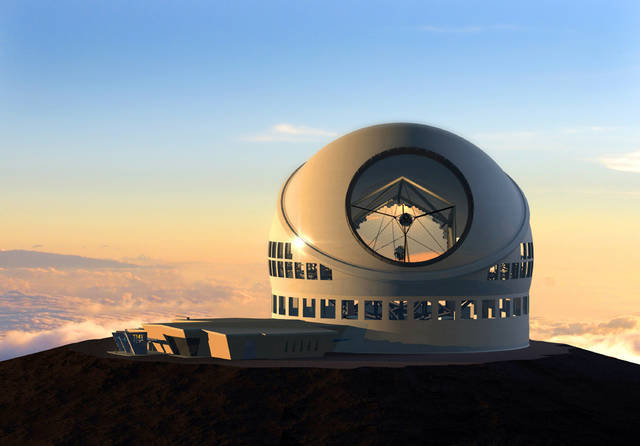On the eve of a court ruling that could determine the fate of the Thirty Meter Telescope in Hawaii, public support for the stalled $1.4 billion project has never been stronger.
And that goes especially for Native Hawaiians, who have shown a dramatic shift in opinion regarding the proposed next-generation observatory, according to the latest Hawaii Poll commissioned by the Honolulu Star-Advertiser.
Conducted March 13-18 by Mason-Dixon Polling & Strategy of Washington, D.C., the poll asked 800 randomly selected registered voters across the state if they support or oppose the construction of the TMT on Mauna Kea.
Some 77 percent of the respondents said they support the TMT, whose fate may rest in the hands of the Hawaii Supreme Court in the coming months. Only 15 percent were opposed, while 8 percent were undecided.
The last Hawaii Poll to ask the question of voters statewide — in January 2016 — found that the TMT was backed by 67 percent of those queried.
But an even more dramatic change was seen among Native Hawaiians.
Two years ago, some 59 percent of Hawaiians statewide told the Hawaii Poll they opposed the TMT’s construction, while only 39 percent offered support and just 2 percent declined to give an opinion.
In the latest poll, 72 percent expressed support for the telescope, while 23 percent were against and 5 percent were undecided.
What happened in the last two years?
“People are starting to realize this opportunity is once in a lifetime. We can’t afford to give it away,” said Richard Ha, director of Perpetuating Unique Educational Opportunities (PUEO), the Native Hawaiian nonprofit that formed to help support the TMT.
But Kailua resident Kawika Villa, 39, a Native Hawaiian who participated in the poll, said he was surprised to hear so many Hawaiians supported the telescope.
“I don’t know any Hawaiians who support it,” he said.
Villa said he opposes the project for cultural reasons and because he doesn’t like the way the University of Hawaii has managed the summit of Hawaii’s tallest mountain, among other things.
“I know that in order to gain favor and approval, a lot of money has been spent to persuade people to back the TMT and to be happy it’s going to be here,” he said. “A lot of people supported rail when it started, but now they see what’s happening, and they hate the rail.”
The state Supreme Court is now weighing two appeals regarding the TMT, one challenging the project’s sublease and the other the conservation district use permit. Oral arguments were heard on the sublease issue last week, while written briefs and responses are still being submitted in the other case.
If the Court grants either appeal, the project could be jettisoned to TMT International Observatory LLC’s backup site in the Canary Islands.
The Hawaii Poll, broken down even further, found an even larger pool of TMT support on Oahu, where 80 percent voiced their endorsement. Only 12 percent opposed, while 8 percent were undecided.
On the neighbor islands, 74 percent of respondents offered their support to the observatory, while 19 percent opposed and 7 percent were undecided.
The margin for error is 3.5 percent either way, which means there’s a 95 percent probability of the truth falling within that range if all voters were surveyed, according to pollster Mason-Dixon. The margin for error on the sub-sample of 535 Oahu voters is 4.3 percent, plus or minus, while it is even higher for a sub-group such as Hawaiians.
Mixed reactions
Asked to respond to the poll results, TMT spokesman Scott Ishikawa said the organization is grateful for the public’s support and encouraged that it continues to grow.
“We remain firmly committed to being good stewards of the mountain and good neighbors in the community. We are deeply respectful of Hawaiian culture, and committed to creating scientific and economic benefits for our state, as well as educational opportunities for Hawaii students,” he said in a statement.
Doug Simons, director of the Canada-France-Hawaii Telescope on Mauna Kea, said he wasn’t surprised by the general upward trend in support for the TMT. He said more people every day are learning about the importance of Hawaii astronomy and its benefits, including an annual economic impact to Hawaii island of more than $90 million.
As for Native Hawaiians, Simons said he was both surprised and amazed at the size of the opinion shift.
He noted, however, that the issue isn’t as volatile as it once was. He said he’s observed less vocal opposition to the TMT in meetings on both Oahu and the Big Island in recent months.
“Maybe that’s reflected in the poll,” he said. “In any case, it’s good news.”
Kealoha Pisciotta, president of Mauna Kea Anaina Hou and leader of the Mauna Kea Hui anti-TMT petitioners, said the TMT question is not a popularity contest. It’s a legal and constitutional question about Native Hawaiian rights and the destruction of the water source, among other issues, she said.
“If they polled people prior to Brown v. Board of Education, they probably would have found that discrimination is OK, too,” she said.
Pisciotta said she finds the poll’s results a little hard to believe, particularly in regard to Native Hawaiians.
“On the Big Island, I don’t see those numbers,” she said. “It’s not a reflection or a feeling I get here — not at all.”
The Hawaii Poll – March 2018: TMT by Honolulu Star-Advertiser on Scribd

